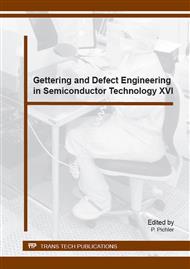[1]
H. Fischer, W. Pschunder, Investigation of photon and thermal induced changes in silicon solar cells, in: Proc. 10th IEEE PVSC, Palo Alto, USA, 1973, pp.404-411.
Google Scholar
[2]
S.W. Glunz, S. Rein, W. Warta, J. Knobloch, W. Wettling, Degradation of carrier lifetime in Cz silicon solar cells, Sol. En. Mat. Sol. Cells 65 (2001) 219-229.
DOI: 10.1016/s0927-0248(00)00098-2
Google Scholar
[3]
J. Schmidt A. Cuevas, Electronic properties of light-induced recombination centers in boron-doped Czochralski silicon, J. Appl. Phys. 86(6) (1999) 3175-3180.
DOI: 10.1063/1.371186
Google Scholar
[4]
S. Rein, R. Falster, S.W. Glunz, S. Diez, Quantitative correlation of the metastable defect in Cz-silicon with different impurities, in: Proc. 3rd WCPEC, Osaka, Japan, 2003, pp.1048-1052.
Google Scholar
[5]
K. Bothe, R. Sinton, J. Schmidt, Fundamental boron-oxygen-related carrier lifetime limit in mono- and multicrystalline silicon, Prog. Photovolt.: Res. Appl. 13 (2005) 287-296.
DOI: 10.1002/pip.586
Google Scholar
[6]
J. Schmidt, K. Bothe, Structure and transformation of the metastable boron- and oxygen-related defect center in crystalline silicon, Phys. Rev. B 69 (2004) 024107.
DOI: 10.1103/physrevb.69.024107
Google Scholar
[7]
A. Herguth, G. Schubert, M. Kaes, G. Hahn, A new approach to prevent the negative impact of the metastable defect in boron doped Cz silicon solar cells, In: Proc. 4th WCPEC, Waikoloa, USA, 2006, pp.940-943.
DOI: 10.1109/wcpec.2006.279611
Google Scholar
[8]
A. Herguth, G. Schubert, M. Kaes, G. Hahn, Avoiding boron-oxygen related degradation in highly boron doped Cz silicon, In: Proc. 21st EC PVSEC, Dresden, Germany, 2006, pp.530-537.
DOI: 10.1109/wcpec.2006.279611
Google Scholar
[9]
A. Herguth, M. Kaes, G. Schubert, G. Hahn, Further investigations on the avoidance of boron-oxygen related degradation by means of regeneration, In: Proc. 22nd EC PVSEC, Milan, Italy, 2007, pp.893-896.
Google Scholar
[10]
A. Herguth, G. Schubert, M. Kaes, G. Hahn, Investigations on the long time behavior of the metastable boron–oxygen complex in crystalline silicon, Progr. Photovolt.: Res. Appl. 16(2) (2008) 135-140.
DOI: 10.1002/pip.779
Google Scholar
[11]
A. Herguth, R. Horbelt, S. Wilking, R. Job, G. Hahn, Comparison of BO Regeneration dynamics in PERC and Al-BSF solar cells: submitted to Energy Procedia (2015).
DOI: 10.1016/j.egypro.2015.07.012
Google Scholar
[12]
K.A. Münzer, Hydrogenated silicon nitride for regeneration of Light Induced Degradation, In: Proc. 24th EUPVSEC, Hamburg, Germany, 2009, pp.1558-1561.
Google Scholar
[13]
G. Krugel, W. Wolke, J. Geilker, S. Rein, R. Preu, Impact of hydrogen concentration on the regeneration of Light Induced Degradation, En. Proc. 8 (2011) 47-51.
DOI: 10.1016/j.egypro.2011.06.100
Google Scholar
[14]
S. Wilking, C. Beckh, S. Ebert, A. Herguth, G. Hahn, Influence of bound hydrogen states on BO-regeneration kinetics and consequences for high-speed regeneration processes, Sol. En. Mat. Sol. Cells 131 (2014) 2-8.
DOI: 10.1016/j.solmat.2014.06.027
Google Scholar
[15]
S. Wilking, A. Herguth, G. Hahn, Influence of hydrogen on the regeneration of boron-oxygen related defects in crystalline silicon, J. Appl. Phys. 113 (2013) 194503.
DOI: 10.1063/1.4804310
Google Scholar
[16]
S. Wilking, S. Ebert, A. Herguth, G. Hahn, Influence of short high temperature steps on the regeneration of boron-oxygen related defects, in: Proc. 28th EU PVSEC, Paris, France, 2013, pp.34-38.
DOI: 10.1016/j.egypro.2013.07.328
Google Scholar
[17]
S. Wilking, S. Ebert, A. Herguth, G. Hahn, Influence of hydrogen effusion from hydrogenated silicon nitride layers on the regeneration of boron-oxygen related defects in crystalline silicon, J. Appl. Phys. 114 (2013) 194512.
DOI: 10.1063/1.4833243
Google Scholar
[18]
A. Herguth, G. Hahn, Kinetics of the boron-oxygen related defect in theory and experiment, J. Appl. Phys. 108 (2010) 114509.
DOI: 10.1063/1.3517155
Google Scholar
[19]
S. Wilking, M. Forster, A. Herguth, G. Hahn, From simulation to experiment: understanding BO-regeneration kinetics: submitted to Sol. En. Mat. Sol. Cells (2015).
DOI: 10.1016/j.solmat.2015.06.012
Google Scholar
[20]
J. Schmidt, K. Bothe, Structure and transformation of the metastable boron- and oxygen-related defect center in crystalline silicon, Phys. Rev. B 69 (2004) 024107.
DOI: 10.1103/physrevb.69.024107
Google Scholar
[21]
S. Rein, T. Rehrl, W. Warta, S.W. Glunz, G. Willeke, Electrical and thermal properties of the metastable defect in boron-doped Czochralski silicon (Cz-Si), in: Proc. 17th EC PVSEC, Munich, Germany, 2001, pp.1555-1560.
Google Scholar
[22]
S.W. Glunz, E. Schäffer, S. Rein, K. Bothe, J. Schmidt, Analysis of the defect activation in Cz silicon by temperature dependent bias-induced degradation of solar cells, in: Proc. 3rd WCPEC, Osaka, Japan, 2003, pp.919-922.
Google Scholar
[23]
S. Wilking, J. Engelhardt, S. Ebert, C. Beckh, A. Herguth, G. Hahn, High speed regeneration of BO-defects: improving long-term solar cell performance within seconds, In: Proc. 29th EUPVSEC, Amsterdam, Netherlands, (2014).
DOI: 10.1016/j.solmat.2014.06.027
Google Scholar
[24]
B.J. Hallam, P.G. Hamer, S. Wang, L. Song, N. Nampalli, M.D. Abbott, C. Chan, D. Lu, A.M. Wenham, L. Mai, N. Borojevic, A. Li, D. Chen, M.Y. Kim, A. Azmi, S. Wenham, Advanced hydrogenation of dislocation clusters and boron-oxygen defects in silicon solar cells: submitted to En. Procedia (2015).
DOI: 10.1016/j.egypro.2015.07.113
Google Scholar
[25]
S.A. McQuaid, M.J. Binns, R.C. Newman, E.C. Lightowlers, J.B. Clegg, Solubility of hydrogen in silicon at 1300°C, Appl. Phys. Lett. 62 (14) (1993) 1612-1614.
DOI: 10.1063/1.108602
Google Scholar
[26]
P. Hamer, B. Hallam, S. Wenham, M. Abbott, Manipulation of hydrogen charge states for passivation of p-type wafers in photovoltaics, IEEE J. Photovolt. 4 (2014) 1252-1260.
DOI: 10.1109/jphotov.2014.2339494
Google Scholar
[27]
C. Sun, F.E. Rougieux, and D. Macdonald, A unified approach to modelling the charge state of monatomic hydrogen and other defects in crystalline silicon, J. Appl. Phys. 117 (2015) 045702.
DOI: 10.1063/1.4906465
Google Scholar
[28]
S. Dubois, N. Enjalbert, J.P. Garandet, R. Monna, J. Kraiem, Light-Induced Degradation and Regeneration in compensated upgraded metallurgical silicon, in: Proc. 23rd EU PVSEC, Valencia, Spain, 2008, pp.1437-1440.
Google Scholar
[29]
B. Lim, A. Liu, D. Macdonald, K. Bothe, and J. Schmidt, Impact of dopant compensation on the deactivation of boron-oxygen recombination centers in crystalline silicon, Appl. Phys. Lett. 95 (2009) 232109.
DOI: 10.1063/1.3272918
Google Scholar
[30]
R. Sondena, A. Holt, A.K. Soiland, Electrical properties of compensated n- and p-type monocrystalline silicon, in: Proc. 26th EUPVSEC, Hamburg, Germany, 2011, pp.1824-1828.
Google Scholar


